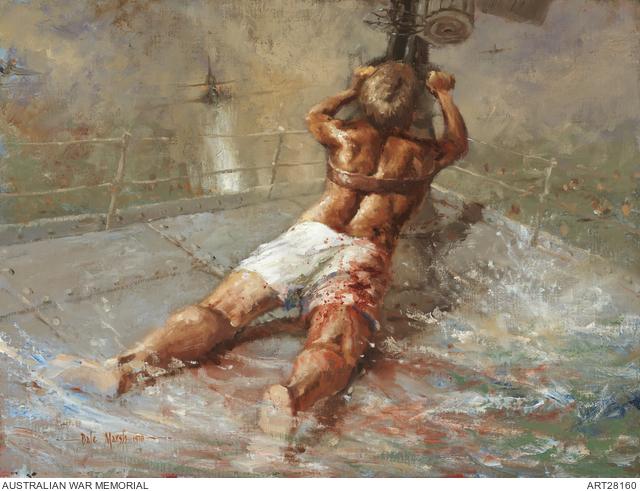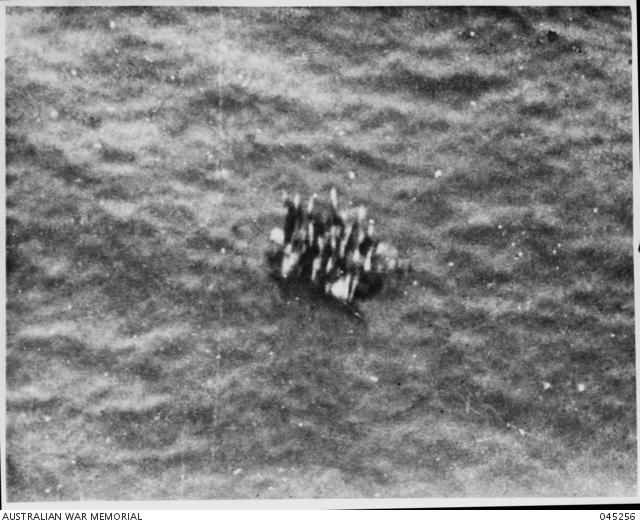Ordinary Seaman Edward Sheean

Teddy Sheean (right) with his brother Thomas, 1941. AWM 044154
Tasmanian-born Edward “Teddy” Sheean joined the RAN on 21 April 1941, following a similar pathway to five of his brothers: four had enlisted for service in the army, and one in the navy. His training took him to Victoria, and later Sydney, where he was billeted on HMAS Kuttabul, a small converted ferry. In June 1942 the Kuttabul was sunk during the Japanese midget submarine attack on Sydney Harbour, but Teddy was at home on leave at the time.
Teddy was posted to the newly commissioned corvette HMAS Armidale, which was carrying out escort duties along Australia’s east and north coast. Upon arrival in Darwin in October 1942, the Armidale was given the task of resupplying and evacuating troops from Timor, and on 1 December it came under attack from Japanese bombers and submarines.
Struck in her port side by torpedos, Armidale immediately began to sink, so the captain gave the order to abandon ship. Teddy was wounded in the chest and back, and as he stood on the deck, preparing to jump overboard, the Japanese planes returned. They flew low over the wreck, firing at the men clinging to the rafts and lifeboats. With complete disregard for his own safety, Teddy raced to his gun and began firing at the planes. He brought down one, and even as the ship sank eyewitnesses recall a tracer firing skywards from beneath the surface of the water as Teddy was dragged under.
Of the 149 men on board, 47 died during the attack. Only 49 survived, rescued from the water a week after the sinking. Teddy was posthumously Mentioned in Despatches for his bravery. After a panel inquiry in 2020, the Australian Government recommended that Teddy also be awarded Australia’s highest military honour, the Victoria Cross. The recommendation was approved by Queen Elizabeth II, and Teddy will now be remembered as Edward Sheean, VC.
Read more about Teddy here.
Activities
- Painted by Dale Marsh, this work of art depicts Teddy firing at the Japanese planes. What words would you use to describe his actions? This painting was created more than 35 years after the Armidale sank: do you think it is a reliable source of information? What sources might the artist have drawn upon?

Dale Marsh, Ordinary Seaman Edward Sheean, HMAS Armidale, (1978, oil on canvas on plywood, 49.5 x 64.8 cm, AWM ART28160)
- The surviving sailors constructed a makeshift raft, to which they attached a half-submerged and badly damaged whaler. The wounded were put aboard a small motor boat that had survived the sinking. When it became clear they would not be rescued, the captain and 21 other men made for Australian waters in the motor boat, rowing much of the way because the engine was damaged. Two days later, another 29 survivors began the same precarious journey in the whaler, by now salvaged but in need of constant baling. The remaining survivors clung to the raft and awaited rescue. The men in the motor boat and whaler were eventually picked up, but those who stayed on the raft disappeared without a trace. This was the last photograph taken of them. How might family, friends, and survivors have been affected by this image?

Survivors of the sinking of HMAS Armidale cling to a life raft, December 1942. AWM 045256
- In 1999 a Collins-class submarine was named HMAS Sheean. This was the first occasion in which a RAN vessel was named after an ordinary seaman. What are some other ways to remember servicemen and servicewomen?
Related objects
References
Royal Australian Navy, “Seaman Edward 'Teddy' Sheean”, https://www.navy.gov.au/biography/seaman-edward-teddy-sheean, accessed 20 July 2020.
Australian War Memorial, “A cruel sea: the sinking of HMAS Armidale”, https://www.awm.gov.au/visit/exhibitions/cruelsea/background, accessed 20 July 2020.